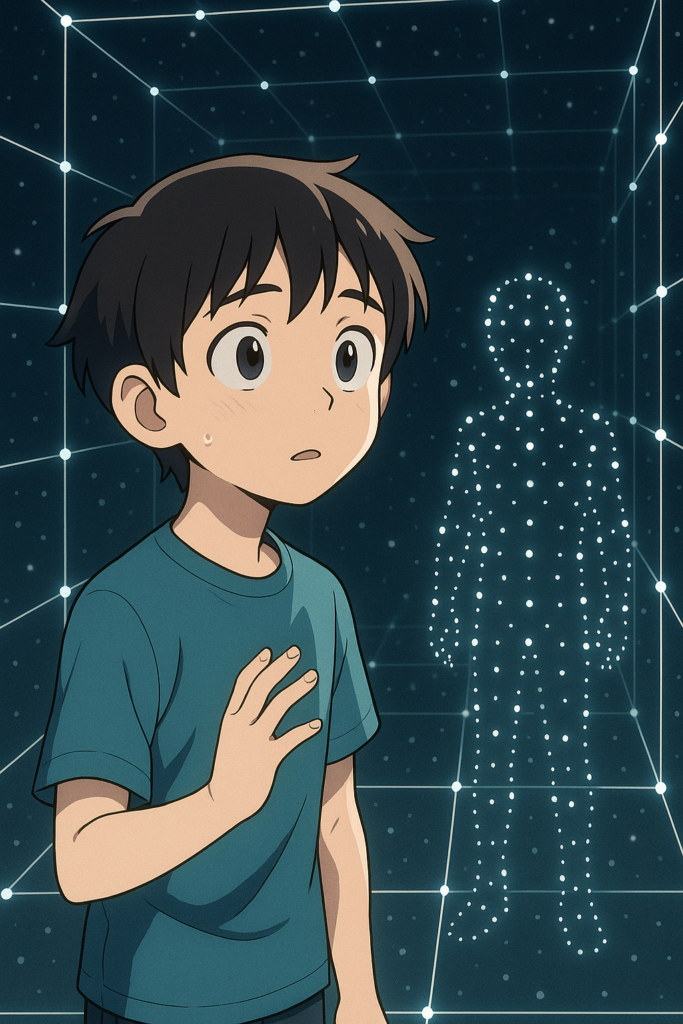They said it was just a worksheet.
Take one and pass it back.
The paper was warm from the copier, still curling slightly at the edges, and when I touched it, it felt like static, like the hum in your fingers before a storm.
On the page were dots. Evenly spaced. Too neat to be random. Too empty to mean anything. A grid, blank and staring.
Someone behind me whispered, “What is it?”
Mrs. Kelser smiled.
“It’s a picture of you.”
I didn’t laugh like the others. Something about the way she said it, it wasn’t a joke. It wasn’t even strange. It was quiet, like a memory from before I was born.
A picture of me. But there were no eyes. No face. Just a pattern, waiting.
The boy next to me began connecting the dots in lines, straight and sharp, like stitching a wound. Others followed. Diagonals. Zigzags. Shapes that wanted to become something but collapsed halfway through.
I didn’t draw.
I watched.
And after a while, the dots started to shimmer, not with light, but with attention. Like they knew I hadn’t chosen yet.
Like they were waiting, too.
And just for a moment, I had the strange and certain feeling that the picture wasn’t on the paper.
It was behind it.
Watching me back.
The paper stayed blank on my desk. Not because I didn’t understand the assignment, but because I did.
Around me, pencils scratched, erasers squeaked, and chairs creaked with the fidgeting of children in search of meaning. Each one tracing lines between dots, trying to pull a person from the static.
The girl to my left connected them in spirals. The boy to my right tried squares. None of it looked like anyone. It looked like trying.
Mrs. Kelser walked the aisles, hands clasped loosely behind her back. She stopped near me but didn’t speak. I felt her watching, but not with judgment. Something older than that. Like she was waiting for a door I hadn’t found yet.
“This is how the world is made,” she said aloud, to no one in particular.
Some heads lifted. Most didn’t.
“By choosing which connections to keep,” she added.
I looked again at the page.
Every time I tried to imagine a line, one dot to another, I saw what I was losing. Each connection erased the possibility of another. Too many, and the pattern collapsed into noise. Too few, and nothing emerged.
No one else seemed to notice. They drew faster, chasing shapes that vanished as they formed.
I put down my pencil.
The page wasn’t broken.
It was complete.
The dots were already connected by the space between them. And when I let go of needing to see it, I started to feel it, an outline not of lines, but of tension, gravity, memory. The shape didn’t want to be drawn.
It wanted to be recognized.
The lunch bell rang. I stepped outside with the others, but something pulled me back.
I returned to my desk while Mrs. Kelser erased the board. The classroom was quieter now, windows half open, the smell of pencil shavings and the scent of dry-erase marker drifting like thought.
She turned, unsurprised to find me there.
“You didn’t draw,” she said. Not a question.
“I couldn’t,” I replied.
She nodded, placed a new worksheet on my desk. More dots, tighter spaced, more than before. The grid hummed beneath the paper like something alive. It pulsed, though I could not say how. I could feel it in my fingertips.
“Try again,” Mrs. Kelser said.
This time, I did.
I drew one line. Dot to dot. Immediate. Wrong. The tension snapped. The shape collapsed. It was like threading a needle through silence, only to hear it scream.
I erased it.
Tried again. A new line. Different direction. Still wrong.
Each connection excluded something vital, something I couldn’t name. The more I drew, the less remained.
By the third line I knew. I was making noise. Not pattern. Static. Not self.
Mrs. Kelser watched, like a lighthouse scanning fog.
And then, the hum.
Low. Gentle. Not a sound, but a shift.
The lights dimmed.
Something formed above the teacher’s desk, a box of faint light, colorless and perfect. Within it, a cloud of glowing dots hung suspended, just like the ones on the paper. But now in air. In depth. In presence.
No lines. No drawing.
Just waiting.
And in that moment, I wasn’t outside it.
It was around me.
Not hovering, holding.
The dots floated in every direction now, above, behind, below. No page. No surface. Just depth.
And I understood the mistake.
We weren’t meant to draw lines.
We were meant to listen.
Voices filtered back slowly, children returning from lunch, the scrape of chairs, the rustle of papers. The classroom reassembled itself around me.
But nothing was the same.
My paper sat untouched on the desk. Blank, except it wasn’t. I could see it now, not what to draw, but what not to.
Each dot shimmered with decision. Every connection I didn’t make whispered a shape more real than the ones I could.
I understood.
The image had never been about completion. It was about permission. To withhold. To choose.
Around me, the others continued drawing, unaware that they had never left the surface. They searched for meaning in the lines. I found it in the spaces between.
Mrs. Kelser looked at me, not surprised. Her eyes were calm, steady, and impossibly deep.
“Now,” she said gently, “close your eyes.”
I did.
The dots returned, this time, all around me.
They weren’t waiting anymore.
They were listening.
“Tell me what you see.”
